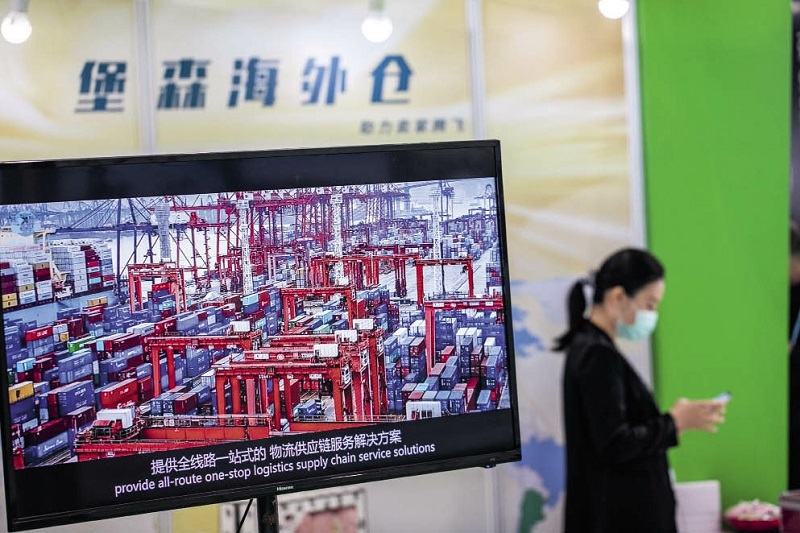Offering fast, low-cost delivery, foreign-based warehouses have become an important platform for the development of cross-border e-commerce. These warehouses are now improving and expanding their global network.

At Cainiao’s warehouse in Guadalajara, Spain, a worker is sorting packages on November 11, 2020.
Overseas Warehouses Gain Popularity
In June relevant authorities in Zhejiang Province released the 2021 list of provincial-level warehouses based in other countries. Among the 13 warehouses on the list, seven were built by Ningbo companies. Among them, Ningbo HOOYA Import and Export Group Co., Ltd. has optimized the logistics management system, and improved the efficiency of goods delivery.
The company’s shipments increased by more than 80 percent last year alone. Refrigerators, washing machines, kitchen appliances, and fitness equipment made in Ningbo were sold all over the world through international warehouses.
Statistics from the Ningbo Municipal Bureau of Commerce show that more than 60 companies in Ningbo have deployed 203 warehouses around the world, covering a total floor space of two million square meters, which account for one ninth and one sixth of the national total respectively in terms of number and area. “As growth in global trade slows down, the development of warehouses abroad can facilitate the “going global” efforts of micro, small and medium-sized enterprises, and inject strong momentum into the manufacturing sector in Ningbo and even Zhejiang on the whole,” said an official from the municipal bureau.
International warehouse is a new business form of global trade emerged amid the boom of cross-border e-commerce. The Report on the Work of the Government of 2016 said that China supported businesses in establishing these warehouses for export products. The General Administration of Customs launched a pilot project for cross-border e-commerce B2B export in July 2020, opening a dedicated channel for goods exported via international warehouses. The State Council issued a circular in November 2020 to promote innovative development of foreign trade, encouraging new business forms and models, especially cross-border e-commerce, including the establishment of a batch of international warehouses.
“Chinese businesses now operate more than 1,900 international warehouses, covering a total space of 13.5 million square meters. Almost 90 percent of those facilities are located in North America, Europe, and Asia,” said Li Xingqian, director of the Foreign Trade Department of China’s Ministry of Commerce. He added that some leading companies have built advanced information management systems for these warehouses to conduct real-time customers, product and delivery information tracking. In addition to the traditional warehousing and distribution business, they have launched more value-added services, such as high-quality after-sales, supply chain finance, compliance consultation, and marketing services.
National policies and documents have been introduced to promote foreign-based warehouses’ development. By 2025, China will have cultivated about 100 international warehousing businesses that will stand out in fields such as information technology, intelligent development, diversified services, and local operations, according to a document recently issued by the General Office of the State Council.

A businessman talks with the representative of an international warehouse logistics company at a trade fair in Jinhua, Zhejiang Province, on September 19, 2017.
Key Advantages
Why are international warehouses popular?
Such facilities allow for quicker customs clearance and faster delivery. “Their operators integrate logistics resources and provide customs clearance services, so the goods entry and exit efficiency is greatly improved. Some offer one- or two-day delivery services in destination countries, greatly reducing the delivery time,” said Li Xingqian.
Cainiao, a global parcel tracking platform of the Alibaba Group, provides international warehouse merchants with a full supply chain solution, and shipment for key countries such as Spain and France will be completed within one to two working days, according to Xiong Wei, CEO assistant and general manager of export logistics at Cainiao.
Exporters can also optimize their inventories and minimize possible losses from unmarketable goods in the warehouses, which can provide amenities such as localized return and repair services. They help shorten the sales cycle, and improve the shopping experience for consumers, added Li.
Since sellers stock up commodities for international markets in advance, in the subsequent restocking, they can choose the lower-priced shipping method to reduce the cost of international logistics. According to Xiong, shipping from Cainiao’s international warehouse is equivalent to domestic shipping, and is less costly than shipping directly from home. For sellers it is more affordable than hiring operators to handle orders and finding their own warehouses. This mode also allows for more effective management of warehouses. “Merchants are able to overcome the restrictions on the weight, volume, and type of goods sent directly in small packages. Especially when the weight of goods is greater than 400 grams, delivery from international warehouses has an obvious cost advantage,” said Xiong.
It is very convenient to operate. Xiong said that after using the Cainiao international warehouse service and completing the preparation process, the transaction order will automatically flow to the system. Outbound logistics documents will be generated, and sent to the international warehouse for picking, packing and delivery. In the case of returns and exchanges, they can also be handled through these warehouses.
“By building overseas warehouses and then shipping goods in bulk to these warehouses to sort, package, and deliver to local customers, Chinese companies can effectively improve logistics efficiency and reduce operational costs,” said Zhang Jianping, deputy director of the Academic Committee and director of the Regional Economic Research Center of the Chinese Academy of International Trade and Economic Cooperation under the Ministry of Commerce. “Against the backdrop of daunting challenges posed by the COVID-19 pandemic to international trade, the benefits of international warehouses of Chinese enterprises are highlighted as there are more adequate stockpiles with faster local delivery.”
“Cainiao now has more than 30 international warehouses across the world, spanning an area of millions of square meters,” said Xiong. “In Europe, there are more than 100,000 square meters of such warehouses, in countries like Belgium, the United Kingdom, Germany, France, Poland, and Spain, extending its delivery services to 24 EU countries and the entire territory of the United Kingdom. Three-day delivery is ensured in the countries where the official warehouses are located and a seven-day delivery in pan-Europe, handling 100,000 orders per day.”
Those Chinese storage facilities established internationally are distributed more widely thanks to the rapid rise of cross-border e-commerce.
China has initially built a policy framework to adapt to the development of new trade forms and models in recent years, according to Ren Hongbin, Assistant Minister of Commerce. He said that China’s cross-border e-commerce imports and exports reached RMB 1.69 trillion (about US $260.9 billion) in 2020, up 31.1 percent year-on-year. Over the past five years, China’s cross-border e-commerce has grown nearly 10 fold. The scale of market procurement trade has increased fivefold in six years, exceeding RMB 700 billion (US $108.3 billion) in 2020.
The explosive growth of the cross-border e-commerce provides opportunities for the development of international warehouses, according to Li Mingtao, chief e-commerce expert of the Institute of China International Electronic Commerce Center. At the same time, these warehouses have become a new form of foreign trade infrastructure to support the development of cross-border e-commerce, and serve as an important link and platform indispensable for the development of cross-border e-commerce.

A Shenzhen-based logistics company is promoting its international warehouse service at the third China International Import Expo held in Shanghai in November 2020.
Smart Warehouses
So how will China develop the international warehouse platform in the future? The answer is to improve the network, enhance the level of digitalization and intelligence, and understand the international rules for operating the warehouses.
Solid steps will be taken to promote high-quality development of international warehouses in the following five aspects, said Li Xingqian.
Traditional foreign trade enterprises, cross-border e-commerce and logistics enterprises, and other entities will be encouraged to participate in the construction of international warehouses through a variety of investment and financing methods. Innovation of financial products such as export credit insurance will be strengthened, mature practices will be copied and promoted, and a number of distinctive and representative international warehouses will be cultivated.
Measures will be taken to improve service networks for the warehouses. “We will accelerate the development of warehouses in key markets to improve the global service network,” said Li. “We will make vigorous efforts to optimize the layout of international warehouses in countries along the China-Europe freight train route and support enterprises to establish a sound logistics system and extend services,” he added.
Efforts will also be made to advance digital development. Operators of international warehouses will be encouraged to promote the online service platforms of integrated pilot zones for cross-border e-commerce, as well as platforms for cross-border e-commerce at home and abroad. This will pool demand and supply information, and make these warehouses more digitized and intelligent.
Unified standards will be established. A number of national, industrial and organizational standards in the field of international warehouses will be formulated to guide the healthy growth of the sector.
International exchange and cooperation will be advanced. Connection with the logistics network of host countries will be enhanced, and international cooperation in the fields like cross-border logistics and business model innovation will be deepened. China will take an active part in making international rules and standards of the global logistics industry.
Enterprises are playing an active part in seizing the opportunity to increase market presence. The State Council document proposes to improve policy measures for express delivery to support enterprises with international warehouses to establish and improve logistics systems, extend supply chain services upstream and downstream, and build smart overseas logistics platforms.
Xiong Wei said that Cainiao is promoting a self-pick up model in Europe to provide better services for local consumers. “Cainiao is planning to deploy nearly 3,000 self-pick-up facilities in Spain, France, and Poland by March 2022, working with local partners to improve the logistics experience for European consumers,” he said, adding that it is expected that by the end of this year, more than 30,000 Cainiao self-pick-up sites will be deployed overseas.
According to Xiong, Cainiao will broaden business in international warehouses by optimizing the distribution, increasing the functions, collaborating with more global partners, and establishing local logistics networks. It will build warehouses in various forms, such as self-built, joint venture, and leasing, according to local conditions. By relying on its domestic and international warehouses and logistics capabilities, the company will provide cross-border merchants with diversified logistics services and supply chain solutions.
KONG DECHEN is reporter of People’s Daily Overseas Edition.